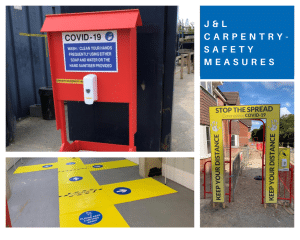- General
Making technology recruitment processes in DACH more accessible
Following on from Part 1 Jack Nugent, Manager from J&L Carpentry continues to discuss the latest developments they have implemented because of the Coronavirus (COVID-19) guidelines.
As we are all aware, the change of pace has been swift and the impact of Coronavirus (COVID-19) will be felt for a long time. At the beginning of the pandemic many construction sites did close. However, during this time J&L Carpentry highlights they were still hard at work preparing for the reopening of their projects to ensure it was a safe environment to continue working at. “Despite our sites being temporarily closed, there was a lot of work to be done to ensure that risk assessments and method statements were adapted to incorporate all of the new COVID-19 guidelines and regulations.”
“As a subcontractor, we have a duty of care to ensure that all of our operatives return home safely every evening. This is something that we are used to; the construction industry is a high-risk working environment regardless of COVID-19, but the rise of the pandemic has increased that risk.”

All workplaces including construction sites not only need to change the physical environment for their staff, but also ensure current paperwork is adapted to ensure a consistent and referenceable procedure is in place for to all staff to use. Organisations need to have a robust plan in place that maintain services and protect the welfare of their employees during the coronavirus (COVID-19) outbreak.
“We sent out specific documentation to all operatives which set out strict rules that they would have to adhere to, in order to keep themselves and others on site safe. This work is ongoing and constantly evolving as we learn how best to implement procedures that work for all the operatives we engage.”
Ensuring that staff are safe is an ongoing procedure and doesn’t just start and end enforcing the social distancing measures and PPE, but a continual process of developing and adapting to government guidelines. A process which Jack and his organisation take seriously.
“We work with some of the largest housing developers in the country, all of whom have been great in ensuring that all operatives and management out on building sites are safely complying with government regulations. Developers have spent tens, and in some cases even hundreds, of thousands of pounds on each project to ensure that work is being carried out safely. These include strict entrance and exit times for each trade, canteen and drying room rotas, the introduction of COVID-19 marshals’ who are responsible for monitoring social distance and the implementation of sanitisation stations throughout each site.
Adjusting to the new normal will take time. Protecting workers safety, adhering to guidelines and dealing with project deadlines which incorporates suppliers and clients will be difficult, whilst all at the same time manging the financial and productivity output will no doubt be a balancing act for the construction industry.
Eventually life will go back to normal, but this period will no doubt leave small resemblances of behaviour and procedures which could improve processes for the better.
Look out for the final part of the J&L Carpentry series where we discuss the knock on effects of the supply chain and how they are managing this process.